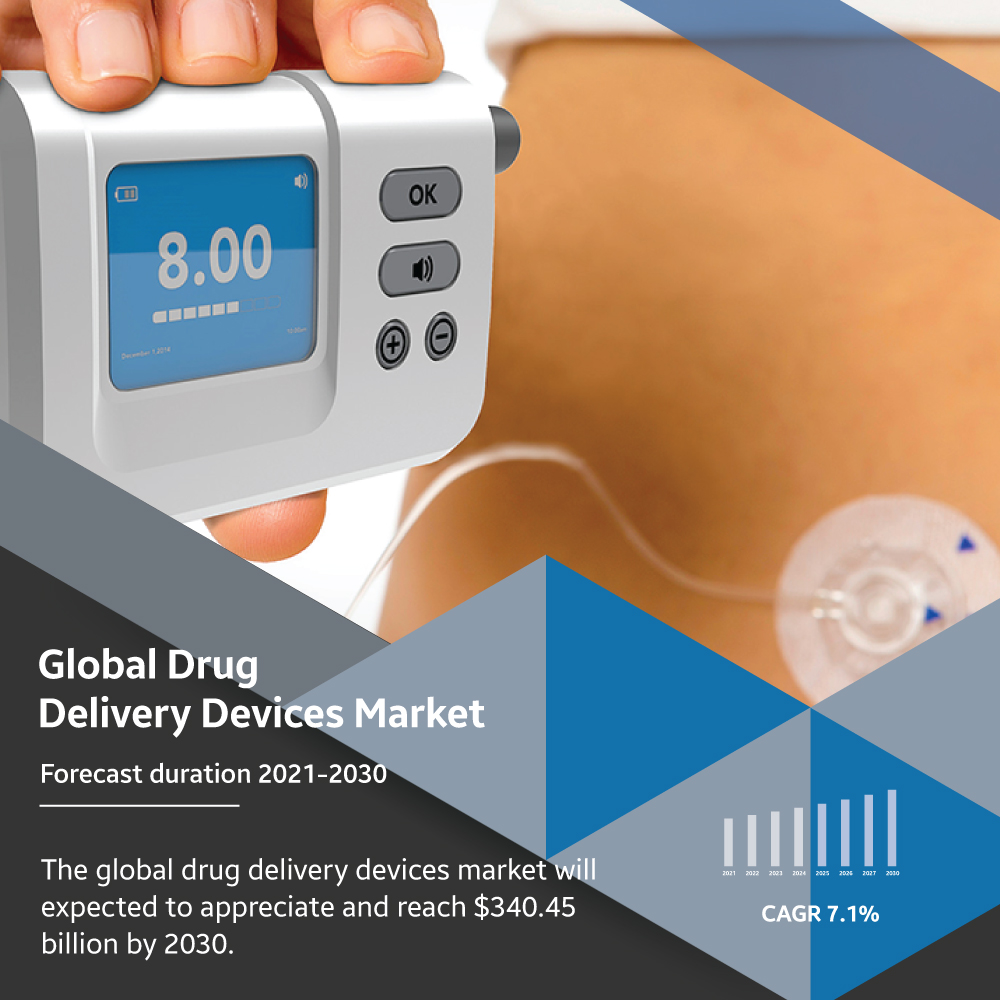Medication delivery devices are specialized tools for a specific drug or therapeutic material administration route. The devices are used once or more during medical procedures. Drug delivery devices present unique challenges in many areas of product development, such as regulatory strategy, design, and material considerations, as well as the creation and use of testing protocols. When providing pharmacological compounds that have therapeutic benefits in humans or animals, drug delivery is a crucial component. Growth in the number of diabetic patients and an increase in the prevalence of cancer and respiratory ailments, are driving an increase in the use of drug delivery systems among patients and professionals.
The market value of drug delivery devices in 2021 was USD 239.2 billion and will reach USD 340.45 billion by 2030, growing at a 7.1% CAGR.
Market Drivers
Innovative drug delivery devices that guarantee the patient receives the proper medication dosage at the appropriate time have been developed due to technological breakthroughs in the medical device manufacturing industry. Additionally, the prevalence of chronic diseases like diabetes, CVDs, cancer, and COPD is increasing, driving up demand for medication delivery systems.
New pharmaceuticals that are efficient in treating various disorders are being developed due to the biopharmaceutical sector’s rapid expansion. The creation of novel new pharmaceuticals is aided by the growing investments made in clinical trials by pharmaceutical companies and the active participation taken by various regulatory agencies like the FDA and EMA. The necessity for varied medication delivery systems is increased because several recently released pharmaceuticals need cutting-edge delivery methods. Additionally, the market growth is boosted by the presence of numerous top competitors and expansion tactics like acquisitions, mergers, partnerships, and the introduction of new products.
Restraints
The market for medication delivery devices is being held back by a lack of standardization, tight drug approval requirements, the danger of nanoparticles entering the brain, a lack of trained specialists to utilize some of the devices, and the greater cost of technologically sophisticated devices.
Opportunities
Industry players are creating new drug delivery technologies. For instance, AstraZeneca is working on products for controlled release, tissue- and cell-specific delivery, as well as alternative methods of administration. There is a need for a device that expands the market potential to deliver newly developed medicine.
Market Segmentation
Route of administration
In 2020, the oral segment held the largest market position. This is due to the oral medication delivery method’s rising popularity because it is painless, patient-friendly, affordable, non-invasive, and self-administrable. Additionally, the majority of medications are offered in tablet, powder, and liquid forms, with oral administration being the preferred method of administration. Therefore, the enormous availability of medications given orally has accelerated the segment’s expansion.
Application Insights
In 2020, the cancer sector held the biggest market share based on application. The growing incidence of cancer in the population is to blame for this. Global cancer cases are predicted to increase by 47% between 2020 and 2040. Globally, 28.4 million instances are predicted to be reported in 2040. Therefore, the main drivers of this market are the rising occurrence of cancers like breast, womb, lung, and bowel cancer.
End User Insights
In terms of end users, the hospital sector’s revenue share was highest in 2020. This is a result of hospitals becoming more widespread globally. The increased public and private sector investments in hospital construction facilitate the expansion of this market segment. Furthermore, the segment’s growth is further fueled by the rise in hospital admissions.
Regional Analysis
In 2021, North America held a maximum market position with 34% of the revenue share. This is due to the increasing incidence of many chronic diseases in the US, including diabetes, cancer, and CVDs. Additionally, the US’s rising healthcare costs and growing health consciousness have accelerated the market’s expansion. More than $12,500 was spent on healthcare per person in 2018. The growing awareness of the availability of numerous cutting-edge drug delivery systems, such as wearable and pen injectors, has considerably aided the expansion of drug delivery devices in North America.
Asia Pacific will grow at a robust rate. This can be related to the increasing prevalence of different diseases due to the population’s changing consumption patterns and unhealthful eating habits. Additionally, the market demand will be fueled by the constantly expanding geriatric population because older individuals are more susceptible to diseases.
Key Players
- Johnson & Johnson Services Inc
- Pfizer, Inc
- uniQure N.V
- 3M
- Bayer AG
- Becton Dickinson
- Sulzer Ltd.
- Novartis AG
- Shenzhen (SiBiono)
- AstraZeneca PLC
- F. Hoffmann-La Roche
- Consort Medical plc (Recipharm Group)
- GeneTech Company. Ltd. (Hubei Tongji Benda Ebei Pharma)
- GlaxoSmithKline plc
- Boehringer Ingelheim group
- Antares Pharma, Inc
- Medtronic Plc
- Insulet Corporation
The market value of drug delivery devices in 2021 was USD 239.2 billion and will reach USD 340.45 billion by 2030, growing at a 7.1% CAGR. The market for medication delivery devices is expanding significantly due to the rising prevalence of chronic illnesses.
